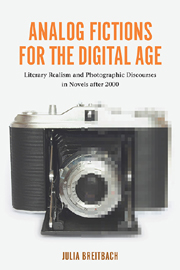 Analog Fictions for the Digital Age
Analog Fictions for the Digital Age Book contents
- Frontmatter
- Contents
- Acknowledgments
- Introduction: Toward a Photographic Reading of Literary Realism
- 1 Photography in the Digital Age: Critical Contexts and the Question of Realism
- 2 This Thing in the Text: Photography, Thing Theory, and the Return to Realism in Literature
- 3 Liminal Realism: Don DeLillo, The Body Artist (2001)
- 4 Domestic Realism: Ali Smith, The Accidental (2005)
- 5 Poetic Realism: Michael Ondaatje, Divisadero (2007)
- 6 Conclusion: The Way We Write Now—A Case for Realism(s)
- Works Cited
- Index
2 - This Thing in the Text: Photography, Thing Theory, and the Return to Realism in Literature
Published online by Cambridge University Press: 05 April 2013
- Frontmatter
- Contents
- Acknowledgments
- Introduction: Toward a Photographic Reading of Literary Realism
- 1 Photography in the Digital Age: Critical Contexts and the Question of Realism
- 2 This Thing in the Text: Photography, Thing Theory, and the Return to Realism in Literature
- 3 Liminal Realism: Don DeLillo, The Body Artist (2001)
- 4 Domestic Realism: Ali Smith, The Accidental (2005)
- 5 Poetic Realism: Michael Ondaatje, Divisadero (2007)
- 6 Conclusion: The Way We Write Now—A Case for Realism(s)
- Works Cited
- Index
Summary
Talkative things instantiate novel, previously unthinkable combinations. Their thingness lends vivacity and reality to new constellations of experience that break the old molds.
—Lorraine Daston, Things That TalkThing Theory: On Humble Objects and Wild Things
Things are a time-honored interest of Western culture and its philosophical, historical, and social debate—from the Kantian/transcendental “Ding an sich” and its repercussions in the works of Nietzsche, Adorno, and Heidegger, to Michel Foucault's poststructuralist critique in Les mots et les choses (1966) or the postmodern sociology of Jean Baudrillard in Le système des objets (1968). In more recent years, things have triumphantly reemerged in the wider field of cultural studies. The angles and disciplines from which scholars tackle the phenomenon are manifold. Anthropology, the field traditionally associated with material culture studies, has seen publications such as Daniel Miller's (2005) Materiality, which replenished the discipline's well-established discussion of “the social life of things” (Appadurai 1986). Other productive areas of research are found, for example, in the history of science, with Lorraine Daston's (2004) Things That Talk. Gathering “object lessons from art and science,” Daston proposes a “thinking with things,” instead of a mere thinking about things (20; emphasis added).
- Type
- Chapter
- Information
- Analog Fictions for the Digital AgeLiterary Realism and Photographic Discourses in Novels after 2000, pp. 48 - 71Publisher: Boydell & BrewerPrint publication year: 2012


